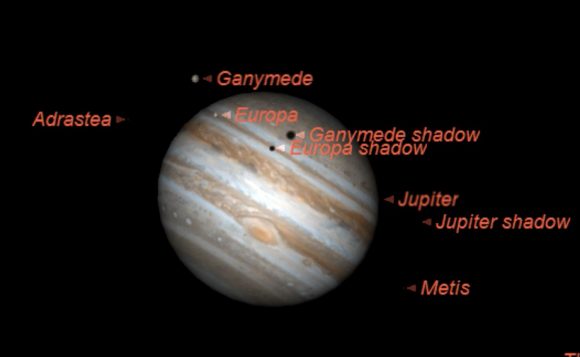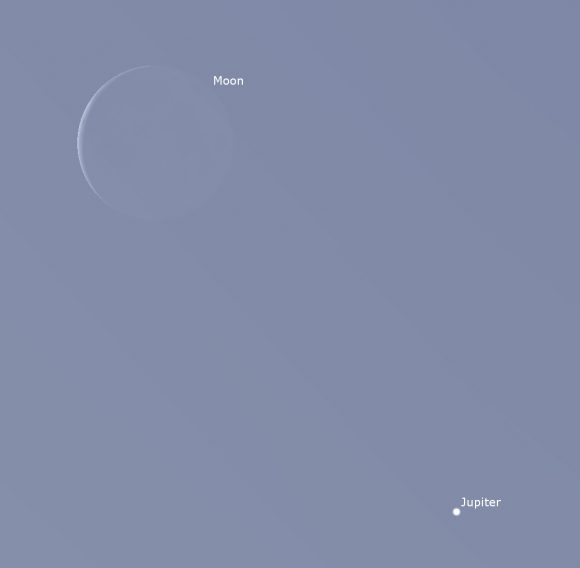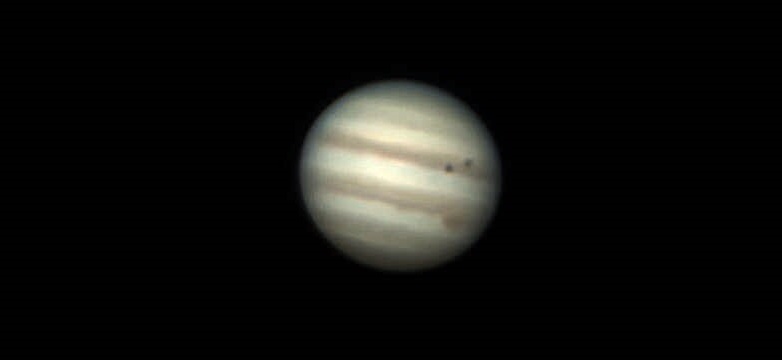Missing Jove? The largest planet in our solar system is currently on the far side of the Sun and just passed solar conjunction on September 26th, 2016. October now sees Jupiter slowly return to the dawn sky. Follow that gas giant, as an interesting set of double shadow transits transpires in late October leading in to early November.
This particular cycle of double shadow transits involves the large Jovian moons of Europa and Ganymede.

Europa and Ganymede double shadow transit season begins later this month, as both cast shadows on the Jovian cloud tops. This series of simultaneous shadow transits runs from October 17th to November 8th, and includes four weekly events.
The inner three large moons Io, Europa and Ganymede are in a 4:2:1 resonance. Europa orbits Jove once every 3.6 days and makes two circuits for Ganymede’s one. This means there’s a double shadow transit once every week in the current season:

When can you first spy Jupiter, post solar conjunction? Catching this particular series of double shadow transits is challenging this time around, owing to the planet’s position low in the dawn twilight. The first event on October 17th starts with Jupiter just 16 degrees west of the Sun, and the cycle ends with Jove 38 degrees west of the Sun on November 8th.
Keep in mind, it is possible to track Jupiter up in to the daytime sky, post sunrise. To do this, you’ll need a ‘scope with a solid equatorial mount and good sidereal tracking. The trick is to lock on to Jupiter before sunrise and track it up in to the dawn sky. Be sure to physically block that dazzling rising Sun out of view behind a hill or building, and NEVER aim your telescope at the Sun!
Using this method opens up the possibility of nabbing a given double shadow event to longitudes due east of the quoted locales above.
The waning crescent Moon also passes 1.4 degrees NNE of Jupiter on October 28th, offering another chance to spy the gas giant in the dawn sky, using the nearby crescent Moon as a guide.

And another interesting pairing is coming right up on the morning of Tuesday, October 11th, when Mercury passes just 0.8 degrees (48′) NNE of Jupiter. Both are only 12 degrees west of the Sun at closest approach, which occurs around 10:00 UT. Still, both will appear as an interesting pseudo-double star, with Mercury shining at magnitude -1.1 and Jupiter only half a magnitude fainter at -1.6.
You can even see Jupiter coming off of solar conjunction and headed toward dawn skies courtesy of SOHO’s LASCO C3 camera:

Callisto, the outermost large moon of Jupiter, ceased casting its shadow on Jupiter earlier this year on September 1st 2016. Callisto is the only large moon that can ‘miss’ the gas giant’s cloud tops. Callisto must be involved for a triple shadow transit to occur, and the moon resumes regularly casting its shadow on Jove on December 4th, 2019.
Callisto can also experience total solar eclipses similar to those seen from the Earth during the mutual eclipse season for Jupiter’s moons, albeit shorter in duration:
And don ‘t forget: we’ve got a spacecraft currently exploring Jupiter for the next year and a half: NASA’s very own Juno.
Be sure to check out the Jovian action over the next month, gracing a dawn sky near you.

